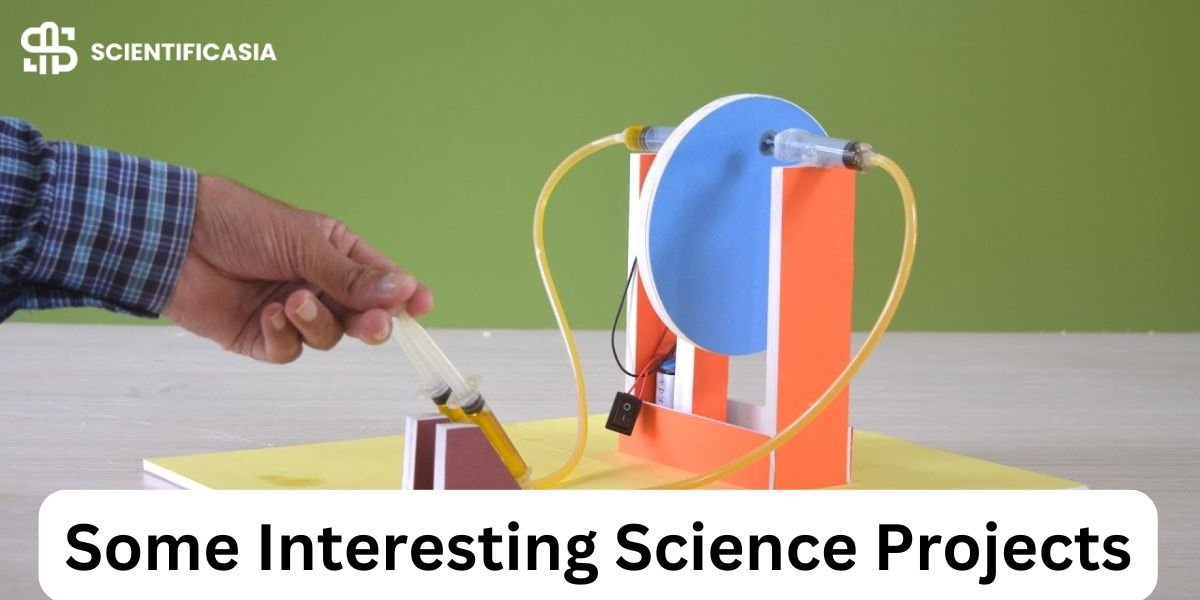Homemade Lava Lamp Science Project
Concept:
This project demonstrates the principles of density and immiscibility. Oil is less dense than water, so it floats on top. The Alka-Seltzer reaction creates carbon dioxide bubbles, which carry the water upward through the oil. Once the bubbles burst, the water sinks back down.
Materials:
- A clear bottle or jar (plastic or glass)
- Water
- Vegetable oil (or baby oil for a clear look)
- Food coloring (any color you like)
- Alka-Seltzer tablets
Instructions:
- Prepare the bottle: Fill the bottle about three-quarters full with vegetable oil.
- Add Water: Slowly pour water into the bottle, leaving some space at the top. The water will sink below the oil because it is denser.
- Add Color: Put in a few drops of food coloring. The drops will mix with the water, creating a colorful contrast.
- Start the reaction: Break an Alka-Seltzer tablet into a few smaller pieces. Drop one piece into the bottle and observe.
- Watch the Magic: The tablet reacts with the water to produce carbon dioxide gas. The bubbles rise, taking some colored water with them. When the gas escapes, the water droplets sink back down, creating a lava lamp effect.
- Repeat: When the reaction stops, add another piece of Alka-Seltzer to continue the fun.
Tips for Extra Fun:
- Use different food coloring combinations to make a multicolor lamp.
- Shine a flashlight through the bottle in a dark room for a glowing effect.
- Experiment with the amount of water and oil to see how it affects the movement.
Safety Note:
This project is safe, but ensure younger children handle the materials carefully and do not ingest any of the ingredients. Dispose of the mixture in the trash rather than pouring it down the drain.
Resource: You can find many educational websites and science experiment sites like Science Buddies or Education.com for similar projects.
Enjoy exploring the fascinating world of science together! 🌟
Volcano Eruption Science Project
Concept:
This project showcases an acid-base reaction. Baking soda (a base) reacts with vinegar (an acid) to produce carbon dioxide gas. The gas bubbles create pressure, resulting in an eruption that resembles lava flow.
Materials:
- Baking soda (3-4 tablespoons)
- Vinegar (½ cup or more)
- Dish soap (1-2 drops)
- Food coloring (red or orange for lava effect)
- Modeling clay or sand (for creating the volcano structure)
- A small plastic bottle or cup (to hold the reaction inside the volcano)
Instructions:
- Build the volcano:
- Use modeling clay or wet sand to form the shape of a volcano around a small plastic bottle or cup.
- Leave the opening of the bottle exposed at the top as the volcano’s “crater.”
- Prepare the Reaction Zone:
- Place 3-4 tablespoons of baking soda into the bottle at the center of the volcano.
- Optionally, add a few drops of dish soap directly onto the baking soda to create a foamier eruption.
- Add Color:
- In a separate container, mix vinegar with a few drops of food coloring to simulate red-hot lava.
- Create the Eruption:
- Slowly pour the colored vinegar into the bottle with the baking soda.
- Stand back and watch as your volcano erupts with a bubbly, foamy “lava” flow!
Tips for Extra Fun:
- Experiment with different amounts of vinegar and baking soda to see how it affects the size of the eruption.
- Try adding glitter to the vinegar for a sparkling lava effect.
- Use multiple volcanoes for a “chain reaction” of eruptions.
Safety Note:
This activity is safe, but supervise younger children to avoid spills or ingestion of the materials. Perform the experiment on a tray or outdoors for easy cleanup.
Resoucre: Websites like National Geographic Kids and Khan Academy provide good educational material on chemical reactions and volcanoes.
Have fun creating your own volcanic eruption! 🌋
DIY Slime Science Project
Concept:
Slime is a fun way to explore polymer science! The glue contains polymers, which are long chains of molecules. When mixed with contact lens solution (containing borate ions), a chemical reaction causes these polymers to cross-link, transforming the liquid glue into stretchy, gooey slime.
Materials:
- White glue (4-6 ounces)
- Baking soda (½ teaspoon)
- Food coloring (optional, for color)
- Contact lens solution (contains boric acid or borate for the reaction)
- Mixing bowl and spoon
Instructions:
- Prepare the Glue Base:
- Pour the white glue into a mixing bowl.
- Add a few drops of food coloring and stir to evenly distribute the color.
- Add Baking Soda:
- Stir in ½ teaspoon of baking soda. This helps the slime thicken and react with the contact lens solution.
- Activate the Slime:
- Gradually add contact lens solution, about 1 teaspoon at a time, while stirring continuously.
- Keep adding until the slime begins to pull away from the sides of the bowl and becomes less sticky.
- Knead the Slime:
- Use your hands to knead the slime until it reaches your desired consistency—stretchy, soft, and not sticky.
Tips for Perfect Slime:
- If the slime is too sticky, add a bit more contact lens solution and knead again.
- For a glittery or textured slime, add glitter or small beads to the glue before activating it.
- Store your slime in an airtight container to keep it from drying out.
Safety Note:
This activity is safe when supervised. Avoid contact with the eyes and do not ingest the slime. Wash hands thoroughly after playing with it.
Resource: Slime-making experiments can be found on ThoughtCo or Science Fun.
Enjoy making and experimenting with your own stretchy slime! 🧪
Solar Oven Science Project
Concept:
This project demonstrates how solar energy can be harnessed for cooking using principles of heat absorption and light reflection. The aluminum foil reflects sunlight into the box, the black paper absorbs heat, and the plastic wrap traps it to create a mini greenhouse effect.
Materials:
- A clean pizza box
- Aluminum foil
- Plastic wrap
- Black construction paper
- Tape or glue
- Scissors or a box cutter (adult supervision required)
- A wooden skewer, straw, or ruler (to prop the flap)
- Marshmallows, chocolate, or other small food items
Instructions:
- Prepare the Pizza Box:
- Cut a flap into the lid of the pizza box, leaving one side attached. The flap should be slightly smaller than the lid itself.
- Fold the flap back to open it like a window.
- Line the Interior:
- Line the bottom of the pizza box with black construction paper to absorb heat.
- Cover the inner side of the flap with aluminum foil, shiny side out, to reflect sunlight.
- Seal the Opening:
- Cover the opening created by the flap with plastic wrap. Tape it down securely to trap heat while allowing sunlight to enter.
- Assemble the Solar Oven:
- Close the box lid and prop the flap open using a skewer, straw, or ruler. Adjust the angle so sunlight reflects into the box.
- Cook Your Food:
- Place marshmallows, chocolate, or other small food items on a plate inside the box.
- Position the solar oven outdoors in direct sunlight.
- Wait and observe as the heat inside the box melts or cooks the food.
Tips for Success:
- Choose a sunny day for this project and keep the solar oven in direct sunlight for the best results.
- Experiment with cooking different foods, like making s’mores or melting cheese on crackers.
- Use a thermometer to measure the temperature inside the box and track how it changes over time.
Safety Note:
Supervise children when using sharp tools like scissors or box cutters. Be cautious when handling hot materials.
Resource: The concept of solar energy can be found at Solar Energy International or Science Kids.
Enjoy creating and experimenting with your eco-friendly solar oven! ☀️🍫
Egg Drop Challenge
Concept:
The Egg Drop Challenge is a fun way to explore physics and engineering concepts like impact force, energy absorption, and design optimization. The goal is to create a structure that reduces the force on the egg, protecting it from breaking during a fall.
Materials:
- Raw eggs (have extras for testing)
- Straws
- Tape (masking or duct tape works well)
- Paper (newspaper, printer paper, etc.)
- Other household items (e.g., cotton balls, bubble wrap, balloons, plastic bags, sponges, rubber bands, etc.)
- A sturdy surface or balcony for testing
Instructions:
- Understand the Problem:
- The challenge lies in creating a device that can prevent the egg from shattering when it is dropped from a height.
- Consider how to absorb the impact and distribute the force.
- Plan Your Design:
- Sketch or discuss your ideas. Think about cushioning materials, shock absorption, and how to keep the egg stable.
- Build Your Contraption:
- Use the materials to create your design.
- Some ideas:
- Cushioning: Wrap the egg in cotton balls, sponges, or bubble wrap.
- Shock Absorption: Create a frame using straws or sticks to absorb the impact.
- Parachute: Attach a plastic bag or paper to slow the fall.
- Test the Design:
- Drop the egg contraption from a height, such as a chair, a staircase, or a balcony.
- Observe whether the egg survives the fall.
- Evaluate and Improve:
- If the egg breaks, identify weak points in the design.
- Make changes to strengthen the contraption and test again.
Tips for Success:
- Use lightweight materials to avoid adding extra force during the fall.
- Ensure the egg is securely held in place to prevent it from shifting during the drop.
- Test from increasing heights to see how well your design performs.
Safety Note:
Perform the test in an open area to avoid damaging furniture or other objects. Clean up broken eggs promptly to prevent messes or accidents.
Resource: Try websites like NASA’s Science for Students or Science Buddies for related engineering experiments.
Enjoy designing and experimenting with your egg drop creations! 🥚💡
Mentos and Soda Geyser
Concept:
This exciting experiment demonstrates nucleation, a process where carbon dioxide bubbles rapidly form on the surface of the Mentos candies. The textured surface of Mentos provides many tiny sites for CO₂ gas to escape from the soda, causing an impressive geyser of soda to erupt.
Materials:
- A 2-liter bottle of diet soda (diet soda is less sticky than regular soda)
- A roll of Mentos candies (approximately 8-10 Mentos)
- A piece of paper or a tube (to act as a candy launcher)
- A wide outdoor area (to avoid a sticky mess indoors)
Instructions:
- Set Up the Soda:
- Place the bottle of soda on a flat surface outdoors.
- Unscrew the cap and make sure the bottle is stable and upright.
- Prepare the Mentos Launcher:
- Roll a piece of paper into a tube that fits snugly around the Mentos or use a Mentos Geyser tube if available.
- Stack 8-10 Mentos in the tube so you can drop them all at once.
- Drop the Mentos:
- Hold the tube directly over the soda bottle opening.
- Quickly release all the Mentos into the bottle at once.
- Stand Back!
- A dramatic geyser of soda will erupt almost immediately, so be sure to step back quickly.
The Science Behind It:
- Soda contains dissolved carbon dioxide under pressure.
- When Mentos are added, their rough, pitted surface provides numerous nucleation sites for CO₂ gas to escape.
- The rapid formation of bubbles creates enough pressure to force the soda out of the bottle in a spectacular geyser.
Tips for Better Results:
- Use a fresh, unopened bottle of soda for the most dramatic eruption.
- Experiment with different types of soda to see which produces the highest geyser.
- Test how the number of Mentos affects the height of the geyser.
Safety Note:
Perform this experiment in an open area and stand at a safe distance to avoid getting soaked.
Resource: Explore HowStuffWorks for the science behind the Mentos and soda reactions.
Enjoy this explosive and educational experiment! 🚀🥤
Build a Simple Circuit
Concept:
This hands-on project introduces the basics of electricity and conductivity. By creating a simple circuit, you’ll explore how electric current flows through conductive materials to power devices like a light bulb.
Materials:
- A small battery (e.g., AA, AAA, or 9V)
- Electrical wires (with insulation stripped at the ends)
- A small light bulb (e.g., from a flashlight or a bulb rated for your battery voltage)
- Electrical tape
- Optional: Items to create a switch (e.g., a paperclip, aluminum foil, cardboard)
Instructions:
- Understand the Circuit Basics:
- A circuit is a closed loop through which electricity flows. The battery provides energy, the wires conduct electricity, and the bulb lights up when the circuit is complete.
- Connect the Battery and Bulb:
- Attach one wire to the positive terminal of the battery using electrical tape.
- Attach another wire to the negative terminal of the battery.
- Connect the free ends of the wires to the bulb’s terminals. The bulb should light up!
- Experiment with a Switch:
- Create a simple switch to control the flow of electricity.
- Use a piece of cardboard as a base.
- Attach one wire to the battery and tape the other end to the cardboard.
- Use a paperclip or aluminum foil to act as the switch. When the foil touches the wire, the circuit is complete, and the bulb lights up.
- Create a simple switch to control the flow of electricity.
- Troubleshoot:
- If the bulb doesn’t light, check for loose connections or ensure the wires are securely attached to the battery and bulb.
Extension Ideas:
- Test different materials (e.g., paper, plastic, coins, foil) to see if they conduct electricity.
- Add more bulbs or batteries and observe how the brightness changes.
- Build a series circuit (one path for current) or a parallel circuit (multiple paths for current) to explore different setups.
The Science Behind It:
- Batteries provide energy in the form of electric potential.
- When the circuit is complete, electrons flow from the battery’s negative terminal, through the wire, into the bulb, and back to the battery’s positive terminal.
- The light bulb converts electrical energy into light and heat.
Safety Note:
Use batteries and bulbs with low voltage to ensure safety. Avoid short-circuiting the battery by directly connecting its terminals without a bulb or resistor.
Resource: Websites like Khan Academy or Teach Engineering offer simple circuit-building experiments.
Enjoy experimenting and learning the basics of electrical circuits! ⚡💡
Grow Crystals
Concept:
This activity demonstrates crystallization, the process where dissolved particles come together to form a solid structure. By growing crystals, you’ll explore how molecules arrange themselves in repeating patterns under the right conditions.
Materials:
- Borax (a cleaning agent available at most stores)
- Hot water (nearly boiling)
- A glass jar or cup
- Pipe cleaners (any color)
- String or thread
- A pencil, chopstick, or skewer
- Optional: Food coloring for tinted crystals
Instructions:
- Prepare the Pipe Cleaner Design:
- Twist pipe cleaners into shapes like hearts, stars, or spirals.
- Attach a piece of string to the top of the design.
- Make the Borax Solution:
- Heat water until nearly boiling.
- Carefully pour the hot water into the glass jar.
- Add borax one spoonful at a time, stirring until it no longer dissolves (a saturated solution).
- Set Up the Crystal Growing:
- Suspend the pipe cleaner design in the jar using the string. Tie the other end of the string to a pencil or skewer and rest it across the jar’s opening.
- Ensure the pipe cleaner hangs in the middle of the jar without touching the sides or bottom.
- Wait and Watch:
- Leave the jar undisturbed in a cool place for 24-48 hours.
- Check periodically to see crystals forming on the pipe cleaner.
- Remove and Display:
- Gently remove the pipe cleaner and let it dry on a paper towel.
- Admire your sparkly creation!
The Science Behind It:
- Hot water dissolves more borax than cold water, creating a supersaturated solution.
- As the solution cools, borax molecules come out of the solution and arrange into a crystal structure, attaching to the rough surface of the pipe cleaner.
Tips for Success:
- Use clear jars to observe the process easily.
- Experiment with different shapes, colors, or concentrations of borax for varied results.
- For a faster experiment, use smaller jars or shorter pipe cleaner designs.
Safety Note:
- Handle hot water carefully to avoid burns.
- Borax is not edible, so supervise children and wash hands after handling.
Resource: Educational websites such as Science Buddies and National Geographic Kids provide crystal-growing experiments.
Enjoy creating dazzling crystals while learning the science of crystallization! ✨
Floating vs. Sinking
Concept:
This simple yet engaging experiment explores buoyancy and density. Buoyancy determines whether objects float or sink based on their density relative to water.
Materials:
- A large, clear bowl or container filled with water
- A variety of small objects, such as:
- Fruits (e.g., grapes, oranges, apples)
- Coins
- Plastic toys
- Paperclips
- Sponges
- Small stones
- A notebook and pen for recording predictions and results
Instructions:
- Set Up the Experiment:
- Fill the bowl with enough water to submerge the objects.
- Gather a selection of objects with different shapes, sizes, and materials.
- Make Predictions:
- Write down each object and predict whether it will float or sink.
- Encourage your child to explain their reasoning for each prediction.
- Test Each Object:
- Gently place each object in the water and observe.
- Record the results: Did it float or sink?
- Discuss the Results:
- Compare the predictions to the actual results.
- Discuss why certain objects floated (e.g., they were less dense than water) and why others sank (e.g., they were denser than water).
The Science Behind It:
- Density: The key factor is whether the object’s density is greater or less than that of water.
- If an object is less dense than water, it floats.
- If it is denser, it sinks.
- Buoyancy: Water pushes up on objects, creating a buoyant force. If the buoyant force is greater than the object’s weight, it floats.
Extension Ideas:
- Peeling an Orange Experiment:
- Place an unpeeled orange in water—it floats!
- Peel the orange and test it again—it sinks! The peel acts like a life jacket, trapping air and reducing the orange’s density.
- Saltwater Experiment:
- Add salt to the water and observe how the buoyancy changes. Items that previously sank may now float due to the increased density of the water.
- Shape and Size Test:
- Test objects of similar weight but different shapes to see how surface area affects buoyancy.
Safety Note:
- Ensure all objects used are safe for children and won’t pose a choking hazard.
- Clean up any spills promptly to avoid slips.
Resource: For buoyancy experiments, check out Science Kids or Khan Academy.
Enjoy this fun and educational dive into the science of floating and sinking! 🌊
Balloon Rocket
Concept:
This experiment illustrates Newton’s Third Law of Motion, which asserts that every action elicits an equal and opposite reaction. When the air rushes out of the balloon, it pushes the balloon forward along the string.
Materials:
- A balloon (any size)
- String (about 10-12 feet long)
- A straw (a flexible drinking straw works well)
- Tape
- Two chairs or similar objects to anchor the string
Instructions:
- Set Up the String Track:
- Thread the string through the straw.
- Secure each end of the string to a stable object, such as the backs of two chairs or any objects that are far apart. Make sure the string is taut (but not too tight).
- Prepare the Balloon:
- Tape the balloon to the straw, ensuring that the nozzle of the balloon points toward the back.
- Leave the balloon unsealed (do not tie it yet).
- Inflate the Balloon:
- Inflate the balloon through the open nozzle. Don’t tie it—just pinch the nozzle to keep the air in.
- The balloon should be inflated enough to create a noticeable force when released.
- Release the Balloon Rocket:
- Release the balloon’s nozzle and observe as it shoots along the string!
- Observe how the balloon moves in the opposite direction from where the air escapes.
The Science Behind It:
- Newton’s Third Law of Motion:
- The air escaping from the balloon creates a force in one direction (action).
- The balloon moves in the opposite direction (reaction), propelling it along the string.
- The balloon’s movement is caused by the pressure of the air inside pushing outward, creating thrust.
Extension Ideas:
- Different Balloon Sizes:
- Try using different sized balloons and see how the size affects the rocket’s speed and distance.
- Angle Experiment:
- Test the balloon rocket on an incline and observe how the angle of the string affects its speed and travel distance.
- Force and Mass:
- Add small weights to the balloon or experiment with different string lengths to see how mass and tension affect the motion of the balloon.
Safety Note:
- Be careful with inflating the balloon to avoid it popping unexpectedly.
- Supervise younger children to avoid accidents with the string and balloon.
Resource: You can find related resources at NASA’s Science for Students or Science Fun.
Enjoy this fun demonstration of action and reaction in motion! 🎈🚀
















